Back in the day, mobility issues were practically a death sentence for dogs. Veterinary science wasn't as advanced as it is today. As a result, paralyzed or injured dogs didn't have the best prognosis. The best course of action after accidents, diseases, or old-age issues was euthanasia.
Luckily, times are a lot different now!
Today, there are many ways to deal with mobility issues! One of the tools for helping dogs get around is a wheelchair for back legs.
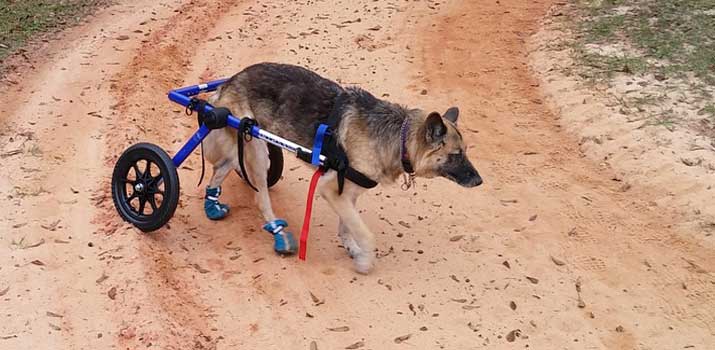
These devices are a product of careful engineering and a better understanding of the physical needs of canines. They help your dog retain his ability to live life while providing some much-needed support for comfort.
Wheelchairs are a colossal advancement in veterinary medicine that improves the quality of life for paralyzed or injured dogs. They add years of life for seniors and prevent owners from having to make potentially life-ending decisions for their furry friends.
Whether your canine companion is suffering from the throws of old age or they're struggling to get around after a paralyzing injury, there's no shortage of wheelchairs to help out. Here are some of the best dog wheelchairs on the market today.
5 of the Best Dog Wheelchairs for Back Legs to Help with Mobility
For Extra Small, Small & Medium Dogs
Best Friend Mobility Elite Wheelchair
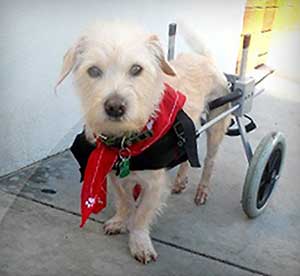
This wheelchair from Best Friend Mobility is considered by many to be one of the best for smaller and medium-sized dogs. Available in a handful of different sizes, the core design remains unchanged.
It features a harness-style system. On the front, an adjustable harness wraps around the chest and shoulders. The harness is relatively easy to slip on and utilizes comfortable materials that are easy to clean. There's even padding to reduce pressure points and provide long-term comfort as your dog plays.
In the rear, you'll find an aluminum frame. The material is lightweight and rust-proof. But, it provides the strength needed to support the rear legs and body. A neoprene sling harness holds onto the body.
All of the metal components that make contact with your pup's body are covered in padding, so there's no worry about chafing or discomfort.
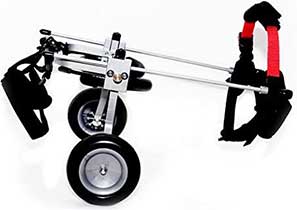
One thing we like about the wheelchair is its versatility. It applies to a range of mobility issues. From amputees to seniors, it serves most dogs very well. The versatility comes down to the adjustable and removable leg slings.
Meanwhile, the pneumatic wheels are tough and ready for action. They feature Swiss ball bearings for smooth movement on any terrain. Not only that, but they are angled outward to ensure that your dog's legs don't get in the way.
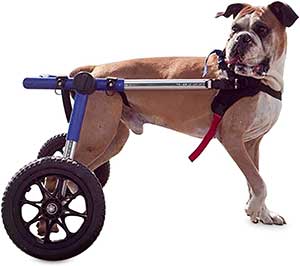
Available in an extensive collection of sizes, this Walkin' Wheels chair is excellent for larger dogs. It can support canines between 70 and 180 pounds! The aluminum frame is lightweight yet rigid. Furthermore, it features a folding design that makes storage and towing a cinch.
The veterinary-approved wheelchair is adjustable. There are multiple points that adapt to your dog's changing mobility needs. Everything from the width of the frame to the height is flexible.
As for the wheels, they don't disappoint. They're available in 12 or 14-inch sizes. Thick treads provide traction on nearly any surface and walking environment.
Adjustable Wheelchair
Two Wheels Adjustable Dog Wheelchair, cart, 7 Sizes for Hind Legs Rehabilitation
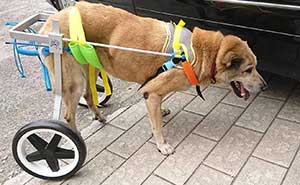
Next up, we have this unit from NewLife Mobility. It's a versatile wheelchair that you can easily fine-tune to meet your dog's needs. Available in seven sizes, it features four wheels and multiple points of adjustment. It's an excellent option for both rehabilitation and long-term mobility assistance.
The frame is made out of lightweight aluminum so that it won't weigh your dog down too much. More importantly, it has exact measurement adjustments. The chair relies on precise measurements, which are printed directly on the aluminum bars for convenience. This chair provides some much-needed support while also protecting the spine and legs.
What is the Purpose of a Dog Wheelchair?
The goal of a canine wheelchair is the same as those for humans. They're built to provide ongoing support to help your pet be a dog again!
No dog owner wants to experience the life-changing impacts of an accident or disease. But, they are more common than most think.
Issues like hip dysplasia, CCL tears, or even arthritis can take hold of older dogs, making it impossible for them to walk a few steps without feeling pain. The same goes for diseases like muscular dystrophy or traumatic injury that causes paralysis.
Despite the things that plague them, dogs are surprisingly resilient. Even pups that go through serious accidents seem to hold onto their energetic and playful nature.
Provide Hope and Get your Dog Back on its Feet!
Ask any dog owner that's gone through this, and they'll tell you that the most challenging part is watching their determined dog struggle.
A canine wheelchair can provide hope and get your dog back on its feet! They provide support to the lower body. Designs can vary a bit. Some act as slings to lift the back feet off the ground completely. Others offer lower body support so that the hind legs drag behind.
Either way, the front legs are free to move as normal. As long as your pooch has adequate strength, they can walk as if nothing is holding them back!
Some determined dogs even get around to sprinting and running! The wheels take the place of the hind legs, giving your pup the freedom to run and play once again.
If you ask us, that's well worth the investment!
When are Dog Wheelchairs Appropriate?
There are many reasons why you might want to consider getting your dog a wheelchair. But before we go any further, it's crucial to weigh your options and get professional guidance.
Wheelchairs can do a lot to improve the quality of life for dogs with mobility issues. But, that's not always the case.
Veterinary Recommendation
First things first, speak with your veterinarian. Your vet knows the ins and outs of the injury that's ailing your dog. Not only that, but they have a deep understanding of how wheelchairs work!
They can gauge the device's effectiveness and determine if it's the right choice for your dog. It's not just the injury that's going to impact the decision. Your pup's existing health will matter, too.
A wheelchair for the back legs will only help with lower paralysis. If it's the front legs that are affected, you'll have to explore other options. Furthermore, the wheelchair will only help your dog if they have the strength in the front legs.
Low strength and control in the front could render the wheelchair useless. Even worse, using a wheelchair could cause further injury.
Never use a wheelchair unless your vet recommends it!
Rehabilitation
If your dog isn't fully paralyzed, wheelchairs are fantastic tools for rehabilitation. In these cases, you'll need a specially designed device that allows the rear legs to touch the ground.
Many dogs can "relearn" to use their legs. It's a long and arduous process that requires tons of patience and therapy. However, a wheelchair may improve your dog's chances of regaining some mobility.
Related: Best Dog Lift Harnesses to Support Injured Back Legs
Full Paralysis
In the event of full paralysis, wheelchairs are a fantastic tool. Your dog relies on its back legs for everything! They need them to walk safely, pop a squat while doing their business, and more.
When rear leg function is taken away after an injury, your pup's quality of life takes a significant nose-dive. Before canine wheelchairs, euthanasia was the only option.
Thankfully, wheelchairs can help paralyzed dogs live life to the fullest! It restores their ability to move, get exercise, and play.
Senior Mobility Problems
Your dog doesn't have to have full paralysis to take advantage of a wheelchair. Issues like muscular dystrophy and hip dysplasia do not remove your dog's ability to walk. But, it can make things extremely painful.
Wheelchairs remove weight off the hind legs, allowing them to move comfortably. In most cases, owners will use wheelchairs for daily walks and heavy play rather than round-the-clock mobility.
The wheelchair can also buy time for treatment and recovery. For example, they make great support tools during the healing process after a CCL tear or bone fracture.
Key Considerations When Choosing a Dog Wheelchair for Back Legs
Once you have your vet's approval, there are still some key factors to consider. The following features and design elements can impact the chair's safety and efficiency.
Veterinary Design and Approval
It's important to reiterate that vet approval is a must! That doesn't just apply to overall usage but also design.
Some dog owners out there have made DIY wheelchairs to support their dogs. While admirable, we advise against this practice. Go with devices that are designed and approved by a vet.
There's always a safety risk with DIY chairs. With an official device made by experts, you can rest easy knowing that your vulnerable dog is in good hands.
Ability to Support Weight
Wheelchairs come in a range of sizes. One of the most crucial things to pay attention to is the size and weight capacity. The last thing you want to go through is having the wheelchair fall apart and injuring your dog.
Go with a unit that supports more than your dog's weight. And as always, consult with your vet!
Lightweight Design
While the wheelchair needs to support your dog, it should also be relatively lightweight. Your dog can only pull so much. In most designs, the brunt of the pressure is on your pup's chest. Get a super-heavy wheelchair, and pulling it along will only cause more pain!
Solid Construction
Solid construction with high-quality materials is a must. One of the best materials for canine wheelchairs is aluminum. Aluminum is lightweight but offers a solid foundation your dog can trust.
Pay attention to any weld points, bolts, hinges, and straps. Also, look at the quality of the wheels! Thin plastic wheels are OK for sidewalk journeys. But if you plan on playing in the grass and dirt, thick wheels with reliable treads are much better!
Collapsible Build
This factor usually only applies to larger dog wheelchairs. Wheelchairs can get pretty clunky, making trips to the vet or your favorite walking spot difficult.
Collapsible wheelchairs solve that problem. They fold down so that you can easily pop them in the trunk whenever you need to take your pup somewhere. Just make sure that the collapsing mechanism locks for safety.
Conclusion
Recovering from an accident, disease, or the effects of old age is never easy. Your furry friend wants nothing but to play and walk! With a high-quality dog wheelchair for the back legs, they can finally live life with a bit of normalcy.
If your dog is in need of some walking support, consult with your vet and check out one of our recommended picks! You won't regret it.
Also Read: Dry, Cracked Dog Paws: Care & Remedies

